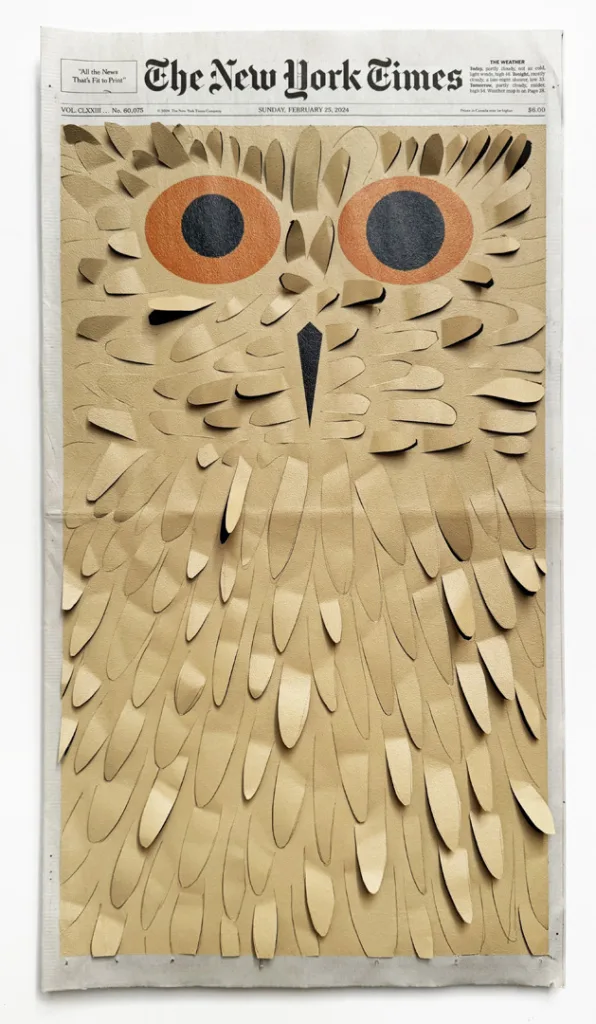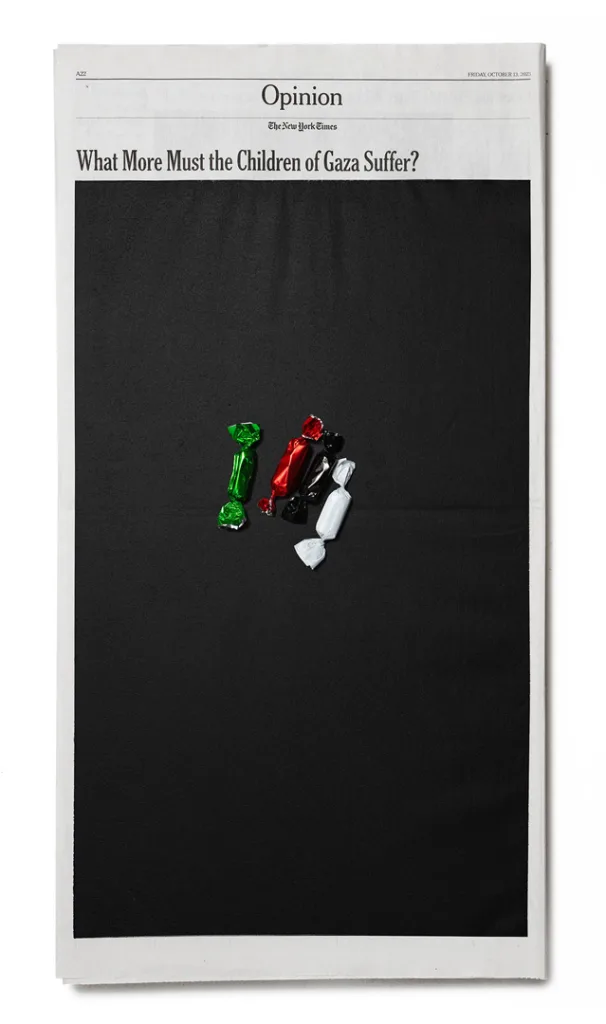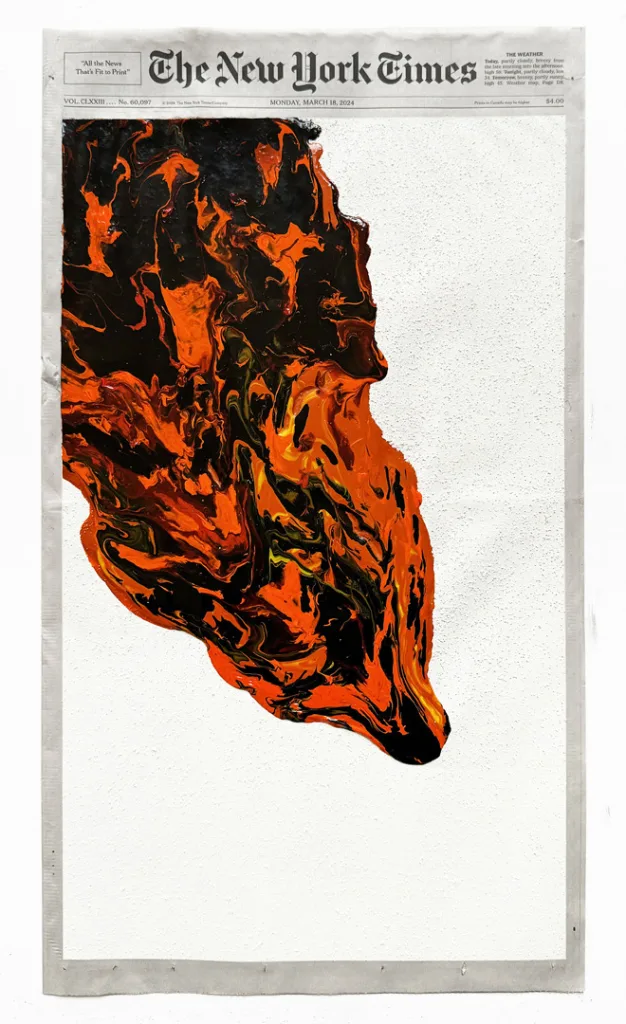It’s currently spring. The world is in a unique state of disarray. A virus is making headlines. In the fall, Joe Biden and Donald Trump will square off.
If you have deja vu, you’re not alone—and it all has me looking to the artist who has painted the news for the past four years.
In 2020, in the early days of COVID, Sho Shibuya’s printed edition of the New York Times brought daily death tolls, news of political bedlam, the murder of George Floyd, and all things beyond. “There were so many chaotic moments,” Shibuya says. “Still, I’d look up, and the morning sunrise was as beautiful as ever . . . and I thought, Maybe I should paint—almost like paint over the news—to make me sane.”
He did just that, painting a small pink sunrise panel, as seen from a small window in his apartment, atop a New York Times cover story with headline: “Gasping for Breaths the Size of a Tablespoon.” And soon enough, thanks to the Instagram account where he posts his work, Shibuya would become one of the viral graphic commentators of our time—a quieter, though no less profound, counterpart to such artists as Edel Rodriguez.
As the world once again feels at an inflection point, you may find yourself, like me, finding renewed solace in Shibuya’s work all over again. But how does Shibuya feel about reentering a new cycle of intense news? The answer may surprise you.

Capturing Time in the Times
Shibuya was born in Fukuoka in Southwestern Japan, and eventually moved to Tokyo, where he studied architecture. By his own admission he didn’t like it and wasn’t good at it—but in the pre-subscription Adobe days, a friend slipped him a copy of Photoshop/Illustrator. Shibuya loved working in the software, and he loved that the posters and stickers he created for friends made them happy, which ultimately fueled his desire to go into design.
After launching a solo practice in 2011, without knowing any English, he found his way to New York City. A few years into his stay, while working at “a startup company selling luggage” (he helped create the visual identity system for viral luggage company Away), Shibuya came across the Date Painting series of midcentury Japanese artist On Kawara. Kawara would paint the current date with exacting, printer-like flair, storing the finished pieces within custom boxes alongside such ephemera as newspaper clippings.
It inspired Shibuya to start a daily practice of making art as a means to reflect on and explore the subject of time, which he did with a series of Japanese Katakana typographic artworks representing the various days of the week. He eventually became obsessed with the notion of capturing time and preserving moments, but when the pandemic hit New York and Shibuya wanted to document its surreal nature, he didn’t feel the Katakana pieces were a fitting frame. So he switched his daily studies of time to the official paper of record, the New York Times. And thus began his sunrises.
“[Painting daily is] almost [like] writing a diary—to me it makes something more beautiful, makes something more powerful,” he says. “The stack of newspapers in my studio is showing [the progression] of time.”
As time went on, his smaller sunrise panels on the front page of the newspaper gave way to all-encompassing full-bleed takeovers, save for the masthead and date. And here’s the thing you don’t realize about Shibuya’s work at first glance: There’s more than what you see on his often-viral Instagram posts. Despite social media being the main public repository of his output, it only showcases a fraction of it. Whereas some people do things “daily”—as in, you know, most days—Shibuya paints his sunrises, which he photographs at dawn, quite literally every single day, even though he doesn’t post all of them. In fact, in what would undoubtedly strike some as impractical, he entirely gave up his commercial design practice Placeholder (which included such clients as Apple, Cartier, Revlon, Saint Laurent) to concentrate on his sunrises and other paintings.
“I really wanted to focus on my time,” he says. “I think time is the most valuable thing.”

All the News That’s Fit to Paint
Shibuya lives by a regimen of ritual and routine—and, yes, that includes reading the newspaper that he’ll eventually paint. As he’s doing so, if he comes across anything that particularly triggers an emotion, it may lead to one of his more involved news item pieces (which he does in addition to his daily sunrise—never in place of it). Over the years, that has led to profound takes on everything from the overturning of Roe v. Wade to school shootings and onto some lighter moments, such as the launch of at-home COVID tests; the passing of Flaco, the owl; or, say, Rudolph Giuliani’s dripping hair dye.
Naturally, those who disagree with him loudly sound off in the comments. But if any of those people were to have a conversation with Shibuya, they would likely find it utterly thoughtful if not meditative. How does he deal with the ire of trolls? He doesn’t. “I respect our differences,” he says. “That’s the beauty of humanity: People think differently, and we are all different.”

On the flip side, he admits he doesn’t know what resonates with people about his work—and he doesn’t really seem all that inclined to find out. He says it’s ultimately a personal practice, and he agrees that, in a way, his newspaper paintings are his way of processing the world around him.

When it comes to what may happen in November (or on any given day, for that matter), he prefers to abstain from dwelling too much on the future, or what his 280,000 followers may expect to see from him when it arrives. “I’m just thinking about today and tomorrow,” he says. “What I have done today is what I’m proud of tomorrow.”
With nearly 1,500 sunset paintings completed, he says he has found his ultimate subject—and he says he has no intention to stop documenting them. Ever. It’s a project he wants to continue for the rest of his life.
Politicians may rise and fall. The world may change. His followers may grow bored and move on to other artwork. But there is comfort in knowing that the sun will rise tomorrow, and tomorrow, etc.—and Shibuya will be right there painting it.
Recognize your brand’s excellence by applying to this year’s Brands That Matter Awards before the final deadline, June 7.
Sign up for Brands That Matter notifications here.
